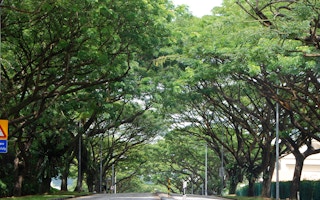Singapore is embarking on an ambitious five-year plan to take stock of and monitor the entire island’s carbon emissions.
The National Parks Board (NParks) wants to set up a system which will allow it to track emissions and how much of it is absorbed by the country’s greenery.
The project, which is expected to start by the end of this year, will even include roadside trees and playing fields, according to a tender document posted by NParks on procurement website GeBiz last month.
Carbon-accounting experts believe the data could help Singapore improve its plans to take better care of the environment.
If the research reveals for example, that a certain plant species absorbs more carbon dioxide, more of those plants could be planted in housing estates, said the experts.
According to the tender, data from the project will be included in Singapore’s Biennial Update Reports to the United Nations, the first of which is due by the end of next year.
This tabulates the country’s greenhouse gas emissions and efforts to reduce them, said NParks director Lena Chan. Parties to the UN Framework Convention on Climate Change, which includes Singapore, agreed to submit such reports during a conference in South Africa two years ago.
In 2010, Singapore emitted around 43 million tonnes - about 0.2 per cent of the world’s output - of greenhouse gases that cause global warming.
If the country had done nothing after 2005 to reduce emissions, its output in 2020 would reach 77.2 million tonnes. The Government has pledged to cut emissions by 7 per cent to 11 per cent below this projection.
As part of the latest project, Singapore’s land will be divided into six categories: forest, cropland, grassland, wetland, settlements and other land.
About 56 per cent of Singapore’s land is covered by greenery. Of this, 27 per cent is actively managed vegetation such as parks and gardens while the other 29 per cent includes swamps, marsh, forest and scrubland.
Land plots will be chosen to represent these categories as well as various vegetation types. Researchers will identify plant species in some of these plots, collect plant and soil extracts and measure their carbon content. Data will be collected annually to track the country’s carbon balance.
One way to quantify the carbon being absorbed in grass, for instance, is to dry a plot sample in an oven, said Dr Alex Cobb from the Singapore-MIT Alliance for Research and Technology, who is involved in a similar project here.
“This gives you the grass’ biomass. Then you take a smaller sample of the dried material and measure its carbon content,” he said. Dr Cobb added that some land categories such as forests would offer more challenges, as they contain more types of plants and trees. One possible method is to record the trees’ diameters and compare them with available data to come up with carbon estimates, he said.
Nature Society of Singapore president Shawn Lum said: “Essentially, for every kilogram a tree grows, about half of that is carbon absorbed from the atmosphere.”
Dr Lum added that NParks could tap on the work of several other projects. The National University of Singapore and National Institute of Education have already compiled some carbon data on Bukit Timah trees, and primary and secondary forests here.










